Archive for ‘Time Management’ Category
Paper Doll Presents 4 Stellar Organizing & Productivity Resources
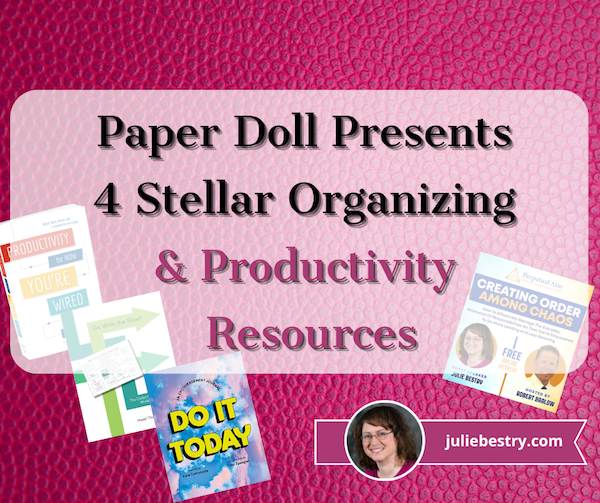
Given that it’s Valentine’s Day week, I wanted to give all of my Paper Doll readers some treats. In this post, we’ll be looking at three books covering organizing, motivation, and productivity, as well as an upcoming video interview series for taking a proactive approach to productivity in leadership.
GO WITH THE FLOW! (The Clutter Flow Chart Workbook)
If you’ve been reading Paper Doll for a while, the name Hazel Thornton won’t be new to you. We’ve been colleagues and friends for many years, and I’ve shared Hazel with you when I interviewed her (along with Jennifer Lava and Janine Adams) for Paper Doll Interviews the Genealogy Organizers and when I profiled her stellar book, What’s a Photo Without the Story? How to Create Your Family Legacy in my 2021 holiday gift list post.
Paper Doll’s Guide to Picking the Right Paper Planner
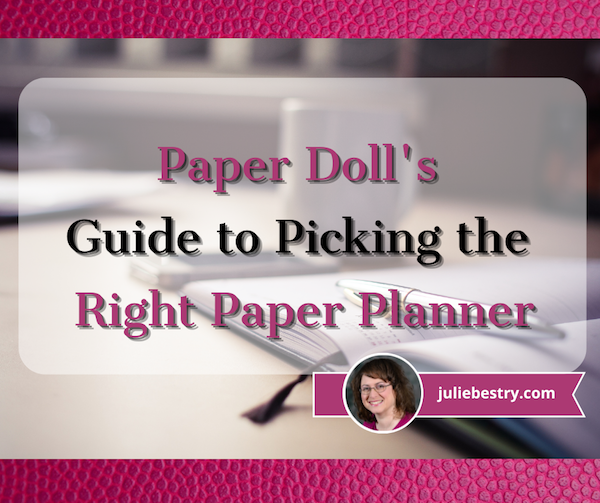
With two weeks until the new year, you’ve probably already started planning for 2023. But if you’re agitated about next year not being any more orderly than this one, you might be hesitating about committing to a planning system. Today’s post is designed to put you more at ease, and give you some guiding principles.
WHY USE A PAPER PLANNER?
There’s nothing wrong with using a digital calendar. I use one myself, though not for scheduling. I use my digital calendar so that when I get an email with Zoom logins, or have a telephone consultation with a prospective client, I don’t have to go looking for the emails to find the links or phone numbers.
In Outlook, I can create an appointment or task directly from an email, and the system will prompt me at a pre-set time with all the key details. It’s like having my own personal Jeeves pop his head into the room to let me know the countess and duchess have arrived to join me for tea.
But honestly, I never use my digital calendar to plan my life. I’m a Paper Doll, so it stands to reason, I prefer a paper planner. But how do you know what’s best for you?
Let’s start with the mindset, and the different advantages and disadvantages of paper planners vs. digital calendars.
Learning Curve
If you are over the age of eight, you already know how to use a paper planner. On the monthly view, there are boxes for the days of the month to put major events, deadlines, and vacations. On the weekly and/or daily views, you can time block for tasks and list appointments.
Digital calendars aren’t complicated, per se, but they are not always intuitive. There might be a generational schism at play, but I’ve had clients try once, twice, even three times to input an appointment, only to have some technical or user kerfuffle lead them astray.
Why does this matter? Digital fatigue creates friction, and friction prevents people from completing a task, whether it’s removing the lid to the laundry hamper to toss clothes in, or schedule an appointment when the system isn’t working.

Woman With Planner Photo by Marten Bjork on Unsplash
Digital fatigue creates friction, and friction prevents people from completing a task, whether it's removing the lid to the laundry hamper to toss clothes in, or schedule an appointment when the system isn't working. Click To TweetControl vs. Convenience
At first, the ease of clicking to accept a meeting invitation would seem like an advantage for digital calendars. But is it?
When I train clients to improve their productivity, we focus on identifying priorities so that we can protect boundaries around them. On a digital calendar in your phone, you generally see the month with blobby dots signifying appointments on particular days.

You have to click through to look at the individual date to schedule the meeting, but then you’re losing the surrounding context because you’re just seeing one appointed after another another in a list. Again, you can’t see time.
When we brainstorm ideas, schedule appointments, break projects into tasks and plan when we’ll do them, we’re thinking about context. When we see a whole month of appointments on the printed page, we instinctually know we have to give ourselves (and our brains) some recovery time. That’s less obvious when we only see the one time slot and the computer merely tells us if there’s a conflict. (Also, on the digital calendar, it’s less clear that you haven’t scheduled time for a potty break or commute.)
Many people — children, college students, people with ADHD, overwhelmed professionals —often suffer from a lack of ability to visualize the passage of time. An analog planner involves more tactile interaction with the appointments and tasks we schedule. As we deal with finding a reasonable time for each time, we gain mastery, not only over our schedules, but our comprehension of time.
Cost
Basic digital calendars are built-in to our phone and computer systems, and most apps are inexpensive. Conversely, paper planners may run you from $20-$50. But when it comes to our planning tools, cost does not necessarily equal value.
Yes, there’s a dollar value to the purchase price of an app vs. a paper planner. But there’s a time value related to mastering a new calendaring system. Are you prepared to commit yourself to learning the intricacies of a new app or the same app every time it updates?
Privacy vs. Searchability
This is another close call. Your paper planner is completely private, as long as you don’t leave it unattended; a digital planner generally syncs across all of your digital devices, which means that while it should be private, there’s never a 100% certainty that there are no prying, hacking eyes.
Conversely, your digital calendar is usually searchable. You can type a keyword or person’s name to find a scheduled appointment or task. Your planner can only be searched by trailing your gaze across each page, and the less careful you are with entering data, the more you risk losing the information when you need it.
Visual vs. Visual+Tactile
When you drive, do you think in terms of linear directions, or are you more inclined to recall what to do when you reach landmarks? If you prefer linearity, go digital; if you like touchpoints and landmarks, paper will likely resonate more.

Hand in Water Photo by Yoann Boyer on Unsplash
Does digital time “feel” real to you? On a digital calendar, every item appears in the same font and size. You can often color-code items, but digital entries have a vague sameness about them.
If you write something down, you can stop thinking of it, per se, and start thinking more robustly and contextually about it. Somehow, dragging an email into Outlook to set a meeting, or typing an appointment into your phone, leads to an out-of-sight, out-of-mind situation for many. But with a tangible paper planner, every time you eyeball your month or your week, you are speedily, comfortingly reminded of the important aspects your life.
Similarly, your fine motor skills applied to the task tend to be the same; you could be typing a grocery list or the key points for an interview (then buried into the notes section of a calendar event). With a paper planner, your tendency to print some things and handwrite others, your ability to use a particular color pen, to draw arrows and circles and adjust the size to shout or whisper on the page, yields a unique temporal language that makes sense to you.
Will a weighty paper planner “feel” more real to you vs. that free app (among dozens) on your phone?
Only you know for sure. For me, it’s a paper planner, all the way. But not all paper planners are created equal.
WHAT TO CONSIDER WHEN PICKING A PAPER PLANNER
Anxiety over making the wrong planner choice is common; it’s one of the reasons people give up one planner and buy another mid-year. You don’t want to plunk $30 or $45 on a pile of paper that will sit like a lump on your desk because you’re afraid to “mess up” a pretty planner. This keeps people from committing to their planners and being successful at scheduling events and tasks.
Some users want simplicity; others desire flexibility. Some clients want aesthetically pleasing planners to inspire them, while others seek a serious, “professional” look. There’s no one perfect planner for everyone, but there are clues in how you feel about potential features.
Page Design
- Adequate space — to show appointments and key information, especially on the monthly view. If you’ve got loopy handwriting, will small monthly view boxes cramp your style?
- Layout for monthly/weekly/daily views — Understand how you “see” time. Also, depending on your life and lifestyle, consider whether you need an academic or full-year calendar, or a planner with lots of extra space for weekend and night activities.
- Creative fields — Modern planners may give you spaces for more than just appointments and tasks. Do you want bubbles or fields or pages for note-taking, brainstorming, mind-mapping, or gratitude journaling?
- Practical fields for tracking metrics — On the flip side of those creative attributes, there are planners with spaces for habit tracking, budgets, meals/nutritional logging, goal-setting, and other countable, observable elements.
- Bonus features — Are you drawn to daily motivational quotes, religious references, or cartoons? I never loved my Franklin Planner so much as the year I was able to get one with a New Yorker cartoon each day. I’ve enjoyed my colorfully-tabbed Emily Ley planner for the last few years, but miss daily quotes and bits of wisdom.
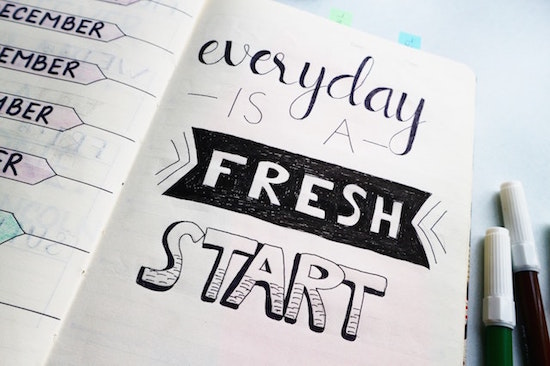
Planner Quote Photo by Bich Tran
Planner Design
In addition to features on the page, you might care about the design specifics of the planner itself:
- Size — Do you think you’d like an executive, classic, or condensed planner? The largest sized planner may not fit in your bag, or may take up too much real estate on your desk, but the tradeoff of picking the smallest option will be losing writing space.
- Weight — Does a hefty paper planner give you a greater sense of gravitas so that you’ll take your schedule seriously? Or will the bulk make it inconvenient for you to carry around?
- Binding — There are ring binders (usually with 7 rings), which let you choose how many pages you want to carry with you at any given time. (I like all the monthly pages, but prefer only last month, this month, and next month for weekly/daily pages.) Coil binding won’t let you remove or add pages, but tends to be more condensed. Both ring and coil binders assure your planner will stay open and lay flat; stitched binding may flop closed when the planner is new, and “perfect” binding (glued, like with a paperback book) can deteriorate with rough handling.
- Cover Style — Do your want your planner to have a leather (or “vegan leather”) cover for a fashion statement? What about a zipper? Are you good with a plastic or stiff paper cover? Will a simple planner cover help you take your planning more seriously or bore you? (Or are you willing to upgrade a staid cover with artwork or washi tape?)
Also remember that your planner is mostly about knowing what you have to do and when. If you need help with project management at the more granular level, take a peek at last year’s Checklists, Gantt Charts, and Kanban Boards – Organize Your Tasks.
PLANNER FORMATS: FOR WHOM ARE THEY REALLY DESIGNED?
As I research planners each year, I find that most planners fall into one of a few general categories:
Basic Planners
Think back to before the computer era, when you’d go to the dentist. Before leaving your appointment, the receptionist would consult a big, black-covered planner with neat columns, flip forward in the book, and write your name for a particular date (column) and time (row). That’s the what you’ll get when you seek various office supply store-branded calendars: columns and rows and not much else.
Basic planners offer a variety of the planner design elements above, but relatively few extra page design options. Popular examples:
At-A-Glance — is the most like that dental office planner in the days of yore. It’s efficient and practical. If you’re easily distracted by colorful design elements, this style should keep you on the straight and narrow.

Franklin-Covey planners in the ring format are customizable. You not only get to pick your planner size, but also choose from a variety of themes. There are spaces for appointments, tasks, and notes on the same page; others have little boxes for tracking expenses. You can also purchase pages for contacts, more notes, budgeting, and a number of other extras.
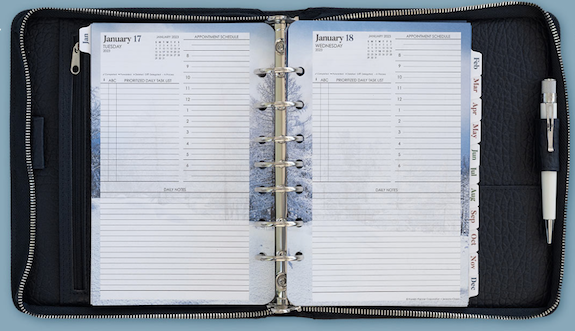
Levenger Circa SmartPlanners come in junior and letter sizes and some DIY customization. They use ring-like discs, such as we discussed in Noteworthy Notebooks (Part 4): Modular, Customizable, Disc-Based Notebooks.

Moleskine planners comes in a wide variety of sizes, colors, bindings and styles for monthly, weekly, daily, and combination views. Much like Moleskine notebooks, these are well made, with curved corners and elastic closures. These are often suited to creative souls who still want to stick to a simpler style and format.
Planner Pads are the planners I recommend the most often to the widest variety of clients. There are monthly calendar pages, but the heart of the system is the weekly pages divided into three sections (projects/tasks, daily scheduled tasks, and daily appointments), which “funnel” the overall projects and tasks to where they belong each day. However, cover choice is limited to black and a sort of seafoam green. I’ve said it for years, but Planner Pads is missing a great marketing opportunity; they already have the best basic planners — why not make them a little more attractive?
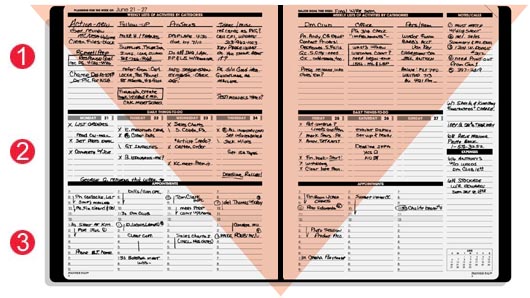
Passion Planners are still pretty straightforward, with columns for each date and sections for work and personal tasks and for notes, but they add weekly sidebars for focus areas and a place to jot down the “good things that happened” that week. The covers are faux leather and come in a variety of sumptuous colors; choose cover design, pick one of three sizes, and decide whether you want your week to start on Sunday or Monday.
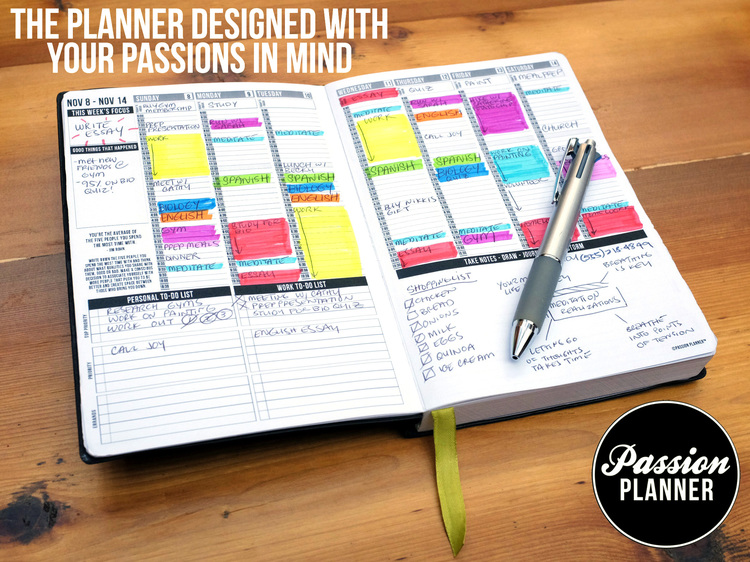
Basic planners are the best for time blocking. (For more on this, see my Playing With Blocks: Success Strategies for Time Blocking Productivity from last year.) They tend to be promoted as gender-neutral options, with rare prompts for life goals or touchy-feely stuff.
“Fancy” Planners
For want of a better term, these are a step up from the basics. It’s worth noting that fancy planners marketed to women tend to focus on aesthetics and tracking emotional/psychological factors; planners marketed to men tend to include more tracking of quantifiable action-based metrics.
There are a handful of smaller sub-categories I’ve noticed in this realm.
The Animal Planners
Panda Planner — In addition to scheduling tasks and appointments, it covers inspiration and goals in sections labeled “Today’s Priorities,” “Morning Review,” and “Things I Will Do to Make This Week Great.”
Organize Your Writing Time for NaNoWriMo 2022
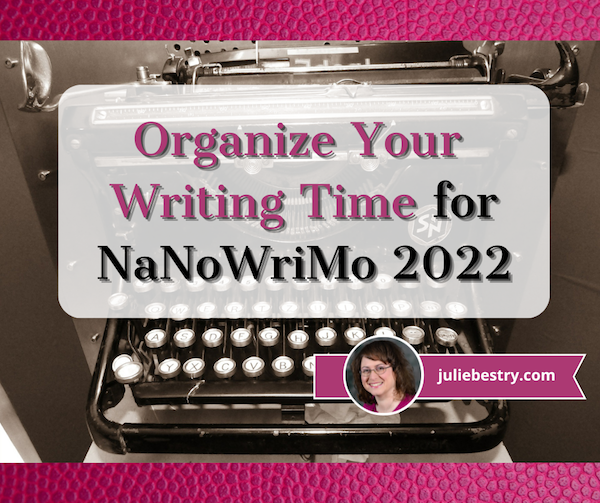
Have you ever imagined writing the Great American Novel?
Does the idea of getting revenge after the end of a turbulent relationship by (barely) disguising your ex as the villain (or victim) in a mystery appeal to you?
Maybe you’ve figured out exactly what Billy Joel was talking about when he sang that “Paul is a real estate novelist” and you’d like to be one too?
(If not, don’t skip out. There are treats here for anyone who wants to organize their time to achieve a goal.)
NaNoWriMo gives you the opportunity to follow your dream.
WHAT THE HECK IS NANOWRIMO?
In the weeks leading up to Halloween, and then all throughout the month of November, you may see #NaNoWriMo pop up in your social media feeds. NaNoWriMo is National Novel Writing Month.
If you’ve ever done a month-long challenge (plank or do yoga every day of January, keep a journal for mindfulness, give up Facebook for a month, etc.), you’ll be familiar with this kind of effort. Except, at the end, instead of a fit core, increased self-awareness, or the calm of not knowing that people with whom you went to high school are bringing about the downfall of civilization, you’ll have written a book!
Each year, NaNoWriMo participants commit to writing a 50,000-word novel between November 1st and 30th of the month. That amounts to an average of 1667 words per day, but it’s only the final count that matters. (Because nobody actually writes on Thanksgiving Day. Too many carbs.)
Sign up on the website, maybe join some supportive forums, and then start writing. You can log your daily count and even get cute little badges for your progress.
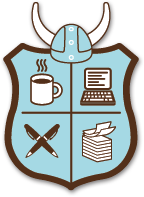
Officially, there are opportunities to prep your novel during September and October, and get guidance for developing a story idea, creating complex characters, constructing a detailed plot outline (because outlines, like maps, get you where you want to go), and building your story’s world.
All of these tasks are popular with plotters (people who create detailed outlines and prepare for the NaNoWriMo experience). Of course, there are also pantsers, authors who prefer to write by the seats of their pants and plan very little.
On a related note, there are also rebelsm with or without a cause. Although it’s designed as National Novel Writing Month, nobody is going to kick you out of the clubhouse for writing your dissertation, a graphic novel, your memoir, or whatever else you feel called to write. You may have noticed that I write really long blog posts — some topping 3000 words! One year, I used November to write most of a dozen blog posts and several articles.
It’s not cheating, it’s rebelling. (Doesn’t that sound a lot cooler? You can just imagine the leather jacket and the motorcycle.)
At any point, you can upload your novel to the NaNoWriMo website and it will verify your word count. When — let’s be confident! “if” is so iffy! — you hit that 50,000 word count, you can say that you’ve “won” NaNoWriMo for the year.
Winners get a certificate and a banner for display on social media accounts or any other web real estate, and you can purchase a T-shirt and other merchandise in the site’s store. Whether you actually publish or not — even if you never show your novel to anyone else — you’ll still know that you took on a challenge (one that didn’t involve surviving a global plague or not strangling any relatives at the Thanksgiving table) and triumphed.
GET BY WITH A LITTLE HELP FROM YOUR NANOWRIMO FRIENDS
Paper Doll readers know that I am all about mutual support, collaboration, and accountability, and so is NaNoWriMo. Throughout November (and actually, all year), you can avail yourself of a variety of writing assistance and support:
- Discussion Forums — for covering everything from navigating genres to developing storylines to filling plot holes and punching up dialogue
- Writing Groups — for writers seeking camaraderie with people of specific geographical regions, writing styles, or needs. There’s a group for writers with ADHD, authors who write fanfiction, and one called “Rom-Com Writers with Procrastination.”
- Regional Support — from as wide a swath as the whole of Africa to as narrow as a neighborhood near you, you can find people to share your journey
- Writing Buddies — NaNoWriMo makes it easy to find writing partners with whom you can trade ideas (or tales of woe)
As a Paper Doll reader, you already know the importance of accountability, but these two posts may also suit you well on your NaNoWriMo path.
- Count On Accountability: 5 Productivity Support Solutions
- Flow and Faux (Accountability): Productivity, Focus, and Alex Trebek
NaNoWriMo are offers both new and archived Pep Talks from professional writers. I mean, if Outlander author Diana Gabaldon, Alex Cross mystery creator James Patterson, young adult novelist John Green, and MacArthur Genius-winning sci-fi writer N.K. Jemison can’t inspire you to write, who can?
If you need more motivation, NaNoWriMo sponsors offer some amazing prizes for both participants and “winners” who meet the 50,000 word goal. These include discounts for writing software (including Scrivener, Pro Writing Aid, NovelPad, and Plottr), digital devices, and writing/publishing support, and more.
So, you’ve decided you’re going to do this. You register, you post a banner and share your goal on social media, and now you’re watching the clock tick down to November. Now what?
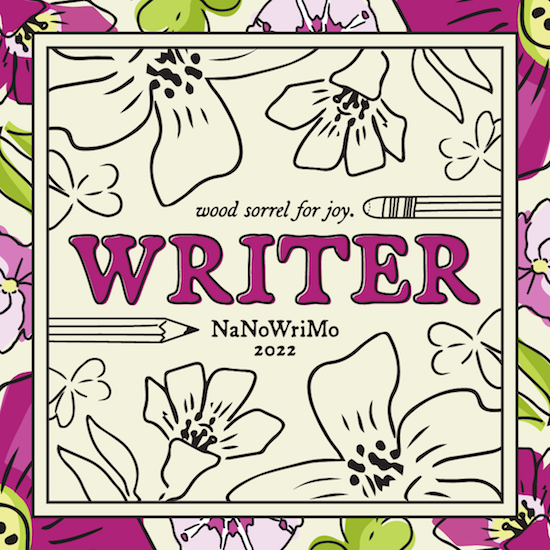
ORGANIZE YOUR WRITING TIME
Last week, I was approached by someone who wanted advice on carving out time to write while still working a full-time job. I was honest; there’s no way to have more than 24 hours in the day, and contrary to what gets thrown around on social media, we do not all have the same 24 hours.
If you’ve got a full-time job (or multiple part-time ones), are raising kids, have a chronic illness, are caring for one more senior parents, or some combination of any of the above, you’re going to have less disposable time (like a temporal disposable income) than a single, healthy twenty-something. Time is not going to freeze and make time for you to write. So, consider stacking a few of these options to achieve your writing goals.
Accept that you have to dedicate specific chunks of time to writing.
You may be a pantser, but that’s about figuring out what you’re going to write. There’s no way to achieve any writing goal, whether writing a novel or finishing a term paper, without deciding when you’re going to write.
If you’re the kind of person who has to feel motivation to do something, I’ve got news for you:
Action precedes motivation.
You have to do something before you’re ready. Your 50K-word novel doesn’t have to be perfect; it doesn’t have to be polished. It doesn’t even have to be good. Your November writing project can be a hot mess!
But here’s my favorite truth about writing. You can’t edit a blank page.
Your 50K word novel doesn't have to be perfect; it doesn't have to be polished. It doesn't even have to be good. Your writing project can be a hot mess! But here's my favorite truth about writing. You can't edit a blank page. Click To TweetSo feel free to write whenever you feel inspired. Nobody’s going to stop you from grabbing your notepad or keyboard or a quill pen (except, maybe the bird from which the feather was plucked). But schedule time to ensure that you have dependable time to write.
The same is true of organizing or anything else you do. Nobody will arrest you for jumping up during a commercial break in Grey’s Anatomy to load the dishwasher. But if you consider dinner tasks to include meal planning, cooking, clearing the table, and loading the dishwasher, and that “dinner isn’t finished until the dishes are done,” then you won’t ever have to dread walking into the kitchen.
Know what you’re going to write.
Even if you’re pantser and don’t know (or want to know) what you’re going to be writing on November 17th, let the back of your brain ruminate while you’re doing mindless tasks like bushing your teeth to get a sense of what you’ll be working on in your next writing session.
If you don’t know what you’re going to write, you will avoid sitting down to write. If you procrastinate and avoiding writing…you will not have written! Sad but true.
And if you do manage to sit down to write with no idea what you’re going to write about, you’ll get distracted. You do not want to get distracted, or you’ll end up with something like this:
Good, great, excellent pic.twitter.com/415p8iwDGH
— Writers’ HQ (@writers_hq) July 13, 2022
If you can’t stand the idea of knowing what you’re going to write ahead of time because you feel like that would mess with the mojo of your creative muse, there’s an alternative to an outline.
Grab a stack of index cards and write down key words or concepts: character’s names, key plot elements, essential conversational high points. Then stuff the carnds in a jar or a hat, and when you sit down to write, grab a card to use as a writing prompt. Yes, you’ll be writing out of order and will have a harder job later on, cutting and pasting, but you’ll be writing!
Block your time…and put some blocks on ice.
Start with my post Playing With Blocks: Success Strategies for Time Blocking Productivity to re-familiarize yourself again time blocking.
Look at your schedule (and if you don’t have one, pull out a paper or digital calendar and hour-by-hour, day-by-day) and write down everything that’s already an obligation. That may be work, school, childcare, other-care, scheduled self-care and personal growth (like yoga or practicing a language or instrument).
What do you use, a to-do list or a schedule? pic.twitter.com/UEG2dH1ES0
— Sarah Arnold-Hall (@saraharnoldhall) September 28, 2022
Then write down all the things you do that aren’t ever scheduled, but which you have to do, from sleeping to grooming to housework and grocery shopping.
Identify blank spaces — if you have any. Those are your first options for writing time. If you’ve got blank space, you might be able to use it to write. (I say “might” because nobody can have all their waking time occupied. We need time to veg out, as I discussed in Toxic Productivity Part 2: How to Change Your Mindset. We can’t create without downtime.)
What if you don’t have any blank spaces? Consider whether you can remove some responsibilities for the duration of November. It’s about priorities. (This is true no matter what life goals you are trying to reach.)
- Can you do one big grocery shop for the month and delegate the urgent milk-and-bread runs to another member of the household? (Or delegate all November grocery shopping and housework to someone whom you support in all of their goal achievement practices?)
- Hire a babysitter for a handful of hours each week?
- Are you willing to get up 45 minutes earlier, or stay up an hour later to get some writing time?
- Can you cut out scrolling through TikTok of your November (or limit it to when you’re standing in line at the store or hanging out anyplace where that you couldn’t otherwise sit down and write)?
- And, as a former broadcasting professional, I can’t believe I’m suggesting this, but could you cut an hour of TV viewing out of your life?
When it comes down to it, there some things you have to do in November: eat, sleep, hydrate, groom, work for pay, take care of dependent humans, and vote. (Please, please remember to vote!) But for 30 days, can you vacuum less? Binge fewer shows?)
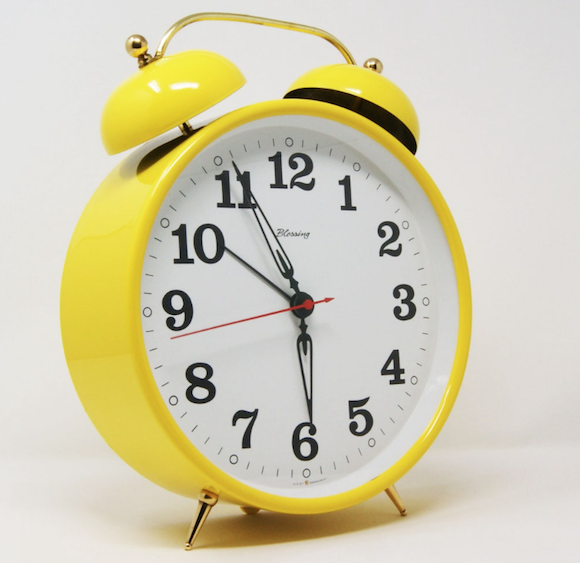
What if you have blank spaces, but they’re short or weird? It’s possible you have lots of writing opportunities, but none are expansive chunks of ninety minutes or two hours. That’s OK. If you have a good outline (that’s where being a plotter has the advantage over being a pantser), you don’t need long blocks of time.
If you have 15 minutes between when you get home from work and everyone else gets home, focus on just one small part of your outline. Are you stuck on the dialogue for a scene for a pivotal conversation between two characters? Play-act the conversation while you’re in the shower or while driving; it’ll help you get the language and tone right; when you’re getting close to how it should sound (and are out of the shower), use the voice memo on your phone or dictate it into a text to yourself to capture the wording. You can transcribe or copy it into your manuscript later.
Rejoice in exploring short writing blocks. It’s less time to dither or second-guess your writing. Focus on getting words on paper. Consider having 25 minutes (one whole glorious pomodoro) the perfect amount of time to work on two or three great paragraphs.
Can you get up 15 minutes earlier and skip 10 minutes of Twitter scrolling to get those 25 minutes? There’s one writing block.
Can you bring your lunch to work so that you use half your lunch hour for eating and relaxing and the other half for writing?
Can you convince your significant other to take over an evening task like laundry, just for November, to give you 25 minutes every evening?
Boom! There’s your writing time!
Let NaNoWriMo figure out your best writing schedule.
NaNoWriMo has a cute social media-style quiz for figuring out the best schedule for your personality and lifestyle. It’ll only take about thirty seconds, and may yield some insight.
Guard your writing time.
Several ago, I wrote R-E-S-P-E-C-T: The Organizing Secret for Working At Home, and many of the concepts apply to helping others in your space respect your time and boundaries. But there are also tips for respecting your own time, staying focused and on-task, and not letting other’s non-emegencies squeeze your time.
Consider what motivates you.
Obviously, you shouldn’t do NaNoWriMo if it doesn’t appeal to you. But before the month even gets started, make a list of all the reasons why you want to do it.
Whether it’s to get back at your 11th-grade English teacher who was dismissive of your creative efforts or to give you confidence that you can step out of your comfort zone, come up with ten big and small reasons you are inspired to write a 50,000 word draft of a novel.
Then write ten more reasons. And ten more after that!
Read one of those reasons aloud at the start of every day in November. Give yourself a fighting chance to overcome inertia and achieve your goal!
Currently stuck in nocturnal. Where are you? pic.twitter.com/9ppvAultN0
— Writers’ HQ (@writers_hq) January 31, 2020
Track Your Progress
Every time I write about NaNoWriMo, I like to share David Seah’s Word Counting Calendar. Print out the black-and-white or color versions. Every day that you write, just log your total word count and then color in the appropriate boxes.

Post the calendar near your writing space to keep you motivated as you progress toward your goal.
EMBRACE THESE RESOURCES
You could write a book (or several) about all the resources available for supporting a writing project. Here are just a few classics and new-for-2022 to help you organize your thoughts, your research, your writing, and your November.

10 Steps to Get Started with Scrivener for NaNoWriMo — Updated for 2022, this list from the ultimate writer’s tool walks you through how to make the software serve your NaNo needs.
Your Essential Guide to Completing NaNoWriMo in Evernote — As an Evernote Expert, I’m constantly finding (and sharing) new ways to use Evernote to support work and personal goals. Anthony Bartlett has gathered some great advice, including linking to essential Evernote templates for creating character profiles, plotting your novel, story premises, and 3-act structures.
12 Creative Writing Templates for Planning Your Novel — Speaking of templates, Forrest Dylan Bryant walks you through a dozen templates, from those listed above to writing trackers to plot and character templates. Don’t reinvent the wheel when you can use Evernote templates to support your writing and story development.
A Novel Strategy: How to Organize Big Writing Projects — Speaking of Forrest, about five years ago, he wrote this nifty post about how to use Evernote to organize your notes for writing a novel.
(P.S. Combining all of the info above, if you’re thinking of using Scrivener, know that you can import your Evernote notes into Scrivener and see your notes and writing area side-by-side. Cool beans!)
What is NaNoWriMo? And How to Win in 2022 — Updated every year, this masterful post from Reedsy has dozens of tips for managing your time, developing your writing ear, and keeping up your motivation.
Write a 50,000-Word Pulp Novel Before Breakfast: My easy no-outline way of writing short novels in four weeks by Amethyst Qu
How to Survive NaNoWriMo in 2022: 17 Top Tips for Success — Self-Publishing School offers a list of winning habits to help make the most of your November.
Although I don’t write about NaNoWriMo every year, there are several posts in the vault, including those from 2017, where I created NaNoWriMoMo and wrote advice for organizing yourself for NaNoWriMo every single Monday of that November. Just type “NaNoWriMo” into the search sidebar on the left of this site to find them.
Whatever you choose to do with the coming month, I hope you take time to plan and organize to help your dreams come true.
Paper Doll Responds When They Say “Be Our Guest”
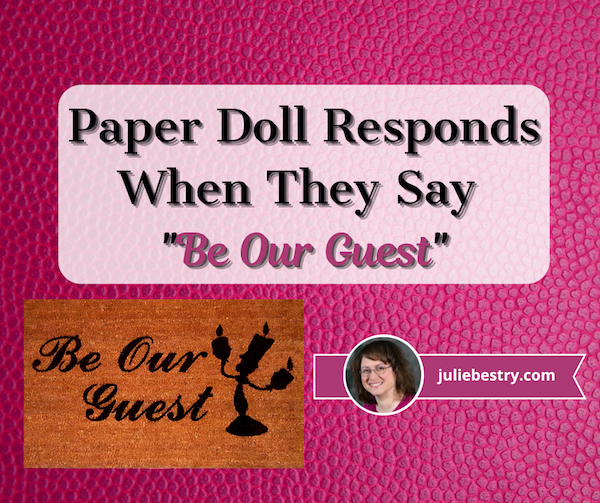
The theme of this week’s post has become somewhat bittersweet since the I originally conceived it. On Tuesday, October 11, 2022, Dame Angela Lansbury passed away at the age of 96. Depending on your age and tastes, you may know Lansbury from various points in her eighty-year career.
If you’re a cinephile, you may know her from films from her earliest role in Gaslight and in the 1940s to The Manchurian Candidate in the 1960s and Bedknobs and Broomsticks in the 1970s, to Anastasia, Mary Poppins Returns and the Knives Out sequel, which hasn’t even been released yet!
If you’re a fan of Broadway, you could have caught her in anything from Stephen Sondheim’s early Anyone Can Whistle to the title role in Auntie Mame to the distasteful pie-baking Mrs. Lovett in Sweeney Todd: The Demon Barber of Fleet Street. And, if you watched television in the 1980s, 1990s, or 2000s, then you probably knew her best as Jessica Fletcher from Murder, She Wrote.
However, if you’ve been a kid or a parent or a baby sitter any time since 1991, then you will recall Lansbury voicing Mrs. Potts (alongside Jerry Orbach’s Lumière) in the classic animated Disney production of Beauty and the Beast. And if you’re wondering what any of this has to do with organizing, here’s a hint:
Perhaps this post’s theme might seem less shoehorned in (if less palatable) if I could sing it to you. But recently, I was asked to serve as a guest and offer advice and information on three disparate topics: productivity, technology, and paper, and I’d like the opportunity to share this material with you.
THE CHATTANOOGA TIMES FREE PRESS EDGE MAGAZINE
On October 20, 2002, almost twenty years ago, in Professional Organizers Are A Growing Trend, I was profiled in the Chattanooga Times Free Press for the first time. Over the years, I’ve been delighted to be interviewed, right up through March 2021, when I was profiled in the newspaper’s Edge, a business-themed magazine.
However, I was particularly giddy when Jennifer McNally, the new editor of Edge asked me to write the October Business Acumen column in an issue devoted to staying productive. While the issue is geared toward professionals and business owners in the Chattanooga region, I think you’ll find it informative and appealing, no matter where you reside or what you do.
You can read the entire October issue of the Edge — my column spans pages 24 and 25, but other columns range from How to Own Failure (and Still Preserve Your Reputation) to the Take It From the Top series with advice from Chattanooga leaders on issues ranging from tracking goals, focus, and discipline to allocating time strategically and anticipating challenges.
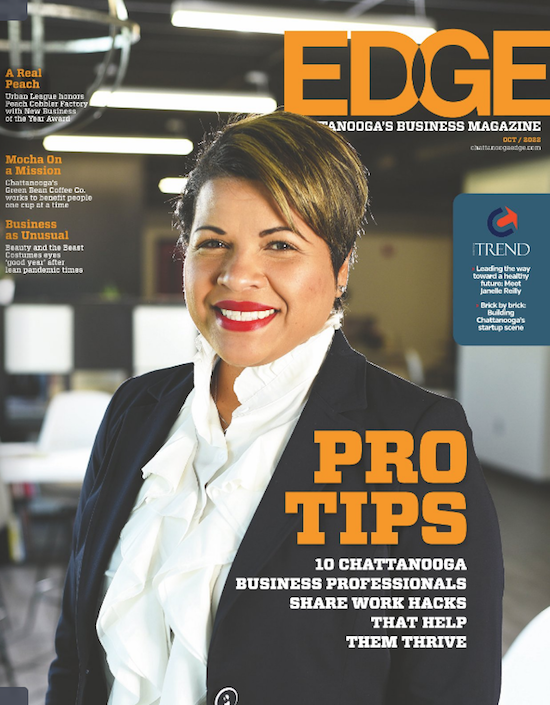
You can also head directly to my guest Business Acumen column, An Expert’s Secrets to Stress-Free Productivity on the newspaper’s site. To give you a taste, it starts with:
Do you feel like life is more demanding than ever, and that effective productivity is hard to achieve? Workdays (and too often, nights) are packed with back-to-back meetings and Zoom calls, Slack notifications and email alerts. Productivity can be elusive.
Maybe you feel like you’re doing more but accomplishing less that rewards you. Increasingly, we’re seeing toxic productivity, where pressure to meet unrealistic expectations zaps physical and mental energy, damaging motivation and self-esteem. But it doesn’t have to be this way.
In the column, I share my strategies for conquering overwhelm by identifying your priorities, protecting your focus, creating flow, and conquering procrastination. I encourage you to take a peek and let me know what you think.
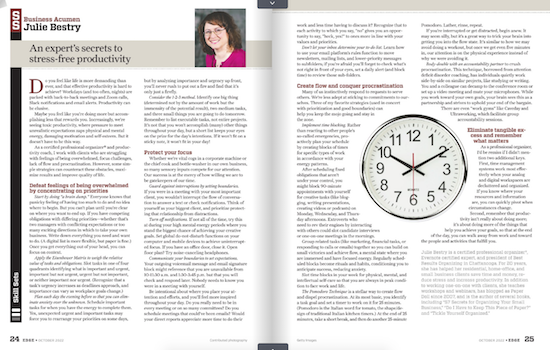
THE STREAMLINED CONNECTION
A particularly charming guest experience was getting to be on my friend and colleague Miriam Ortiz Y Pino‘s video podcast, The Streamlined Connection.
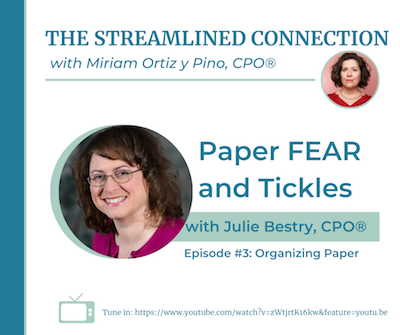
Miriam is a Certified Professional Organizer and Money Breakthrough Business Coach. Her company is More Than Organized, and she’s a firecracker! Like me, she’s been at this for more than two decades, and Miriam’s got an amazing way of creating transformation.
Miriam offers one-on-one in-person and virtual services including organizing, business coaching, speaking, and training in a variety of areas (including the fascinating topic of Sacred Money Archetypes). Miriam also delivers Streamlined Solutions courses for tackling clutter, time troubles, and paper, and live and virtual group workshops for professionals.
It’s an absolute trip to talk to Miriam, because every conversation yields insight. So, I was tickled to be the first guest on her show.
As a Paper Doll reader, you will not be surprised that, when given the opportunity to talk about organizing, I chose my favorite topic, paper. However, unlike when I talked about the philosophical aspects of Why Paper Still Matters on the NAPO podcast earlier this summer, Miriam and I went in a different direction.
On Organizing Paper with Julie Bestry: Paper FEAR and Tickles, we explored the nitty gritty of the frustrations of different types of paper clutter, and how strategically considering both fear and tickles can help you dig out from under.
Miriam has since had some organizing and productivity industry rock stars as guests, including Amy Payne, Regina Lark, Geralin Thomas, Mike Vardy, Leslie Josel, Robyn Reynolds, and Nietra Rose! (Seriously, check it out!)
ORGANIZED ASSISTANT
The amazing (and Canadian) Janet Barclay has graced Paper Doll‘s pages many times over the years. I’ve known Janet since the days before modern social media, when we were both getting the hang of things on Ryze.com. (Don’t go visit; it’s all spam now. Sigh.)
Although Janet started out as a professional organizer and productivity consultant, she eventually found and perfected her niche in supporting organizing professionals. She works her magic as a “website caregiver and designer,” which means she helps people keep their online identities afloat so we can focus on our own clients. She rocks that way.
But Janet rocks another way, as one of the biggest cheerleaders of the organizing and productivity profession. Her Organized Assistant web site is home to blog posts and articles that provide a broad perspective for those of us who work in the field, but she also created the Productivity and Organizing Blog Carnival for the reading public, collecting monthly themed posts on categories ranging from organizing junk drawers to efficiency in the workplace to organizing when a member of the family is ill.
I’m proud to say that I’m one of Janet’s Megastar Blogggers, having contributed to more than 50 monthly carnivals, and am joined by my fancy-pants colleagues Hazel Thornton, Linda Samuels, Sabrina Quairoli, and Seana Turner.
 In the spring, I referenced having recertified as an Evernote Certified Expert. As I often talk about the reasons I love and use Evernote, Janet asked if I’d like to share the certification process with her readers, and I was only too excited to do so.
In the spring, I referenced having recertified as an Evernote Certified Expert. As I often talk about the reasons I love and use Evernote, Janet asked if I’d like to share the certification process with her readers, and I was only too excited to do so.
As an Evernote user, it was easy to pull together my resources for the guest post. I had notes from my original certification as an Evernote Certified Business Consultant in 2015, then as an Evernote Certified Consultant a few years later, and now under the current program, an Evernote Certified Expert. Evernote’s so-powerful-it’s-spooky search capacity found everything I needed to write Adventures in Becoming an Evernote Certified Expert. (This also means I had no excuse for procrastinating on actually writing it!)
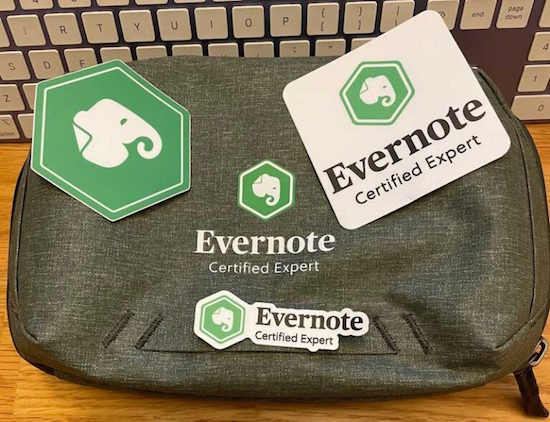
Hopefully, you’ll be entertained as you learn about my experience getting certified, and it may encourage you to get certified, use the skills and support of an Evernote Certified Expert, or just learn more about Evernote in its newest incarnation as so much more than just a note-taking app.
Writing this, I’m shocked to realize it’s been nine years since I’ve written an entire post about Evernote. It’s a completely different platform now, with so many more features and opportunities to organize your digital life. So, don’t be surprised to see more Paper Doll posts in the future regarding how you can use Evernote to be more organized and productive.
BE YOUR GUEST?
As much as I love working with my in-person and virtual clients, giving presentations, and writing this blog, it’s even more fun when I get to share a (digital) stage or blog space. As I’ve reported, throughout 2022 I’ve been on a variety of podcasts and have guested at various summits, about which you can read more:
Paper Doll on the NAPO Stand Out Podcast: Why Paper Still Matters
Paper Doll Picks: Organizing and Productivity Podcasts
Paper Doll on Planning & Prioritizing for Leadership
Paper Doll Shares Secrets from the Task Management & Time Blocking Summit 2022
Not enough Paper Doll for you? You can also check out my Press Room page for more links to interviews and guest spots.
If you have a podcast, summit, or blog for which you might like to interview me on topics related to paper and information organizing or productivity, please feel free to use the Contact page on my site to let me know how we might work together.
ONE LAST LOOK AT MRS. POTTS & LUMIÈRE
Paper Doll cannot live by organizing alone, and I hope that as my guests, you take some delight in the pop culture cameos that have populated this blog since 2007.
Whether solving crimes as Jessica Fletcher or making the worst pies in London as Mrs. Lovett, or getting nominated for Academy Awards, Tony Awards, Golden Globes, or Emmy or Grammy Awards, Angela Lansbury was beloved. And as Lumière to her Mrs. Potts, Jerry Orbach (Law & Order‘s Lennie Briscoe, Baby’s father in Dirty Dancing, and in oodles of other roles on stage and screen) was no slouch, either. With that, I’d like to close today’s post with this behind-the-scenes view of how they put together “Be Our Guest.”
Thank you for being my guest at the Paper Doll blog, and thank you for letting me be a guest on your computer and mobile devices all these years.
Do (Not) Be Alarmed: Paper Doll’s Wake-Up Advice for Productivity
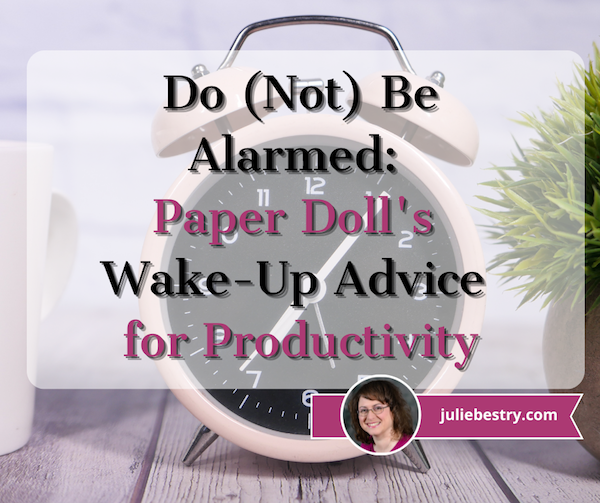
September’s approach means many things: a new school year, a new television season, Europeans coming back from their August-long vacations.
But in September, when I see kids lined up for the school bus, I remember when I went to kindergarten and Paper Mommy bought me a giant, orange, retro, two-bell alarm clock.

(I realize this is yellow and not orange, but we don’t have a photo of my childhood alarm clock. This is a very close reproduction.)
You could see the clock from any vantage point in my room, and the ring was sonorous. There was no way I’d ever oversleep and miss the school bus with that loud din. (Initially, as with all school-related things that year, I was excited. But it takes about three days of being awakened by something that loud for the delight to wear off.)
If you think about it, time management and productivity begins with waking up in time to set your plans in motion, so I thought we’d take a foray into idea of waking up on time.
A SHORT HISTORY OF ALARM CLOCKS
The alarm clock — even the very concept of waking up at a specific time — is fairly new.
Throughout history, people were generally awakened by natural occurrences: the sun rising (and warmth on one’s face or light in one’s eyes), the crowing of roosters, the crying of babies, or the call of nature. City dwellers might have been awakened by church bells or street noise, but farmers far from villages were dependent upon their own natural body clocks and the people and animals around them.
These not-very-specific waking hours were not a problem for most people until the Industrial Revolution in the 19th century. Before that, unless you were within proximity of a clock tower or your family had the wealth to own a clock at home, it was enough to speak generally of meeting someone at dawn’s first light or midday or supper time. However, with the advent of trains (and the ability to catch them) and factory work, it became essential to know the specific time of day. That included waking up on time.
Before the invention of alarm clocks (and into the twentieth century), city dwellers in the UK hired “knocker uppers,” people who would literally knock on one’s windows and doors with everything from broom handles to batons (as in police sticks, not beauty pageant contestant’s silver poles with streamers) to pea shooters! Believe it or not, some people continued “knocker upper” subscriptions long past the invention of alarm clocks; in fact, the last knocker upper service in the UK didn’t cease until the 1970s, long after the rise of household electricity and clock radios.
If you didn’t mind having a giant water wheel handy, you could have been awakened on time (to the sound of a powerful chime and a puppet show) with the assistance of the Water-Driven Spherical Bird’s-Eye-View Map of the Heaven, invented by Chinese monk Xi Ping in the year 725.
Although the first mechanical alarm clock was invented in 1787 by American Levi Hutchins but his design was never patented. Sixty years later, Antoine Redier in France patented the first adjustable alarm clock wherein each hour on the clock’s dial/face had a hole; if you wanted to get up at 7, you put a pin next to the hole next to the number seven. Want to get up on the half hour (or any time except on the hour)? You were out of luck.
It wasn’t until 1876 (which may seem a long time ago to you GenZ and Millennial readers, but that was only eleven years before one of my grandfathers was born) that an American patented a more workable alarm clock and began mass-producing them.
For more on the history of alarm clocks, from the World War II era shortage (due to the use of all spare metal for wartime production) to the development of clock radios, snooze alarms, and my beloved college-era SONY Dream Machine (in production from 1960s until the early 2010s),
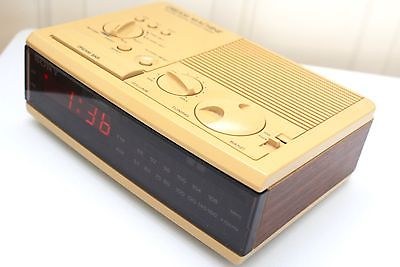
you can read Atlas Obscura’s lovely piece on the 2000-Year History of Alarm Clocks and All That’s Interesting’s How Did People Wake Up Before Alarm Clocks?
HAS PAPER DOLL FALLEN INTO A TIME WARP?
Are you fearing that Paper Doll has had an alarm clock dropped on her head?
You may be wondering why I’m talking about alarm clocks. After all, hasn’t everyone replaced alarm clocks with their smart phones? Yes, pretty much, most have.
But Paper Doll has a secret for you. Quite a bit of research finds that you might be healthier and happier using an actual alarm clock rather than your phone. And a happier, healthier you has a better chance of being productive and getting things done.
YOUR PHONE AS AN ALARM CLOCK, YAY OR NAY?
Sure, there are good reasons to use your phone as your alarm clock:
- You and your phone are already inseparable. You’re much more likely to trust it than a hotel’s front desk wake-up call or even your spouse’s promise to wake you up.
- It takes no effort to set your phone’s clock to the right time. Your cell phone provider already links your phone’s clock to the atomic clock of wherever you’re located by its connection to low-orbit GPS satellites; it (usually) even readjusts automatically when you change time zones. (If you’re not connected to cell towers, your phone’s internal clock takes over until the next time in connects to the network.)
- You can set your phone to wake you up with your favorite song or sound. Whether you’d like to wake up shaking your groove thing to Lizzo’s About Damn Time or prefer to pretend that you’re standing in for Bill Murray in your own version of Groundhog Day, there’s audio for you.
- There are lots of different alarm clock apps for iOS or Android to help you either ease into your day or be shocked out of your sleepy stupor, depending on which you prefer.
However, the ubiquity of phones in our lives is part of the reason they can be harmful in the bedroom:
Light at night is bad for us.
Harvard researchers found that increasing the amount of nighttime light study participants received increased their blood glucose levels similar to those found in people who are pre-diabetic. The nighttime light also decreased participants’ levels of leptin, the hormone that makes you feel satiated after a meal, so you stop grazing between dinner and bedtime and throughout the next day. So, too much light at night can impact your health, overall, and your waistline.
While any light at night can wreck our sleep, this is especially true of blue light. And yup, the screens on our digital devices (like our phones) tend to make use of blue wavelengths. This is a double-edged coin.
The blue light wavelengths are great during the day, as they amp up our moods, our reaction time, and our ability to stay focused and attentive. Yay, blue!
But those same wavelengths of blue light at night tinker with our circadian rhythms, making it harder to fall asleep. All that unnatural light tricks our bodies into thinking it’s still daytime, and so we don’t feel that pleasantly fuzzy sleepiness that makes it easy to drop off without worry or care. Boo, blue!
In fact, while all night light suppresses the production of melatonin, a hormone that controls our circadian rhythms, blue light is the most potent. So, not to scare you, but as cozy at it is to have your phone under your pillow or at your bedside, it’s not worth that blue light messing with your sleep and putting you at risk for obesity, hypertension, or diabetes.
Scrolling, and especially doom scrolling, spells doom for our sleep quality.
Watching any screens in the hour or two before bed is bad for us because of that blue light. But the content on our phones can be just as precarious.
Doom scrolling is the compunction to engage in negative information. When doom scrolling through Twitter or your favorite news feeds, keeping up with what’s going on in the world, you’re probably finding a preponderance of bad news, things that will stress you out and make you angry or frustrated.
It’s not your fault. Our brains are wired to experience a negativity bias, wherein (controlling for the emotional power of a piece of information), we’re more likely to see something negative as having a deeper impact on our lives than something positive. A study at the University of Sussex found that doom scrolling is more likely to make us feel anxiety, stress, fear, depression, and sense of isolation. (And yes, this got worse during COVID.)
Let’s not forget dopamine. Dopamine works when you’re scrolling through social media the same way it works when you’re pulling the arm (or pushing the button) on a slot machine. Dopamine is a hormone that works like a drug, urging you to seek further gratification, which may be a TikTok video that makes you laugh or a tweet confirming your negativity bias that a particular politician is leading to the ruination of all that is good and holy.
Of course, it doesn’t have to be social media. Video games, movies, videos, and TV shows are all (generally) energizing, and the last thing we should be engaging in before sleepy-bye time is whiz-bam-pow!
All of this is bad for your before-bed brain in the same way that letting a toddler get all “sugared up” and run around in the hour before bed will make it harder to get them to sleep. That’s why we focus on good sleep hygiene for tiny humans, giving them baths and stories and snuggle time, in hopes of relaxing them off to dreamland. Grownups need that help to power down, too.
And for those of you who are partnered, a phone-free bedroom mean an increase in the likelihood of intimacy, whether that’s relating emotionally or canoodling.
Scrolling is just as bad in the morning as at night.
Everything we need to avoid at night so that we can wind down and get to sleep is still going to be there when we wake up. But does it have to be there the very minute we wake up?
Whether it’s an email your boss sent off at 2 a.m., a tragic news story from the other side of the world, or whatever is “trending,” your phone can be a royal messenger of frustration.
Give yourself some time in the morning to ease into your day, whether that’s with your significant other, children, or pet. Even just having some quiet time between waking and breakfast can help you create the right mood for the day.
So, I challenge you to banish your phone from the bedroom.
REPLACE YOUR PHONE WITH AN ALARM CLOCK
So, if you’re not going to let the not-so-dulcet tones of your phone wake you up and start your heart racing, what should you use? Unless you have the funds (and the trust) to hire a knocker upper, an old school two-bell alarm clock or travel might be just the ticket. (Or, the noise might set your teeth on edge.)
Of course, it doesn’t have to be old school. There are some nifty modern alarm clocks that might be better suited to your particular needs, from glowing sunrise-simulation clocks that gently wake you with the kind of light that’s healthy for starting your day to clocks that shake, rattle, and roll you to your feet.
Here is just a sample of what you might consider, especially if you tend to hit the snooze button until the last possible moment.
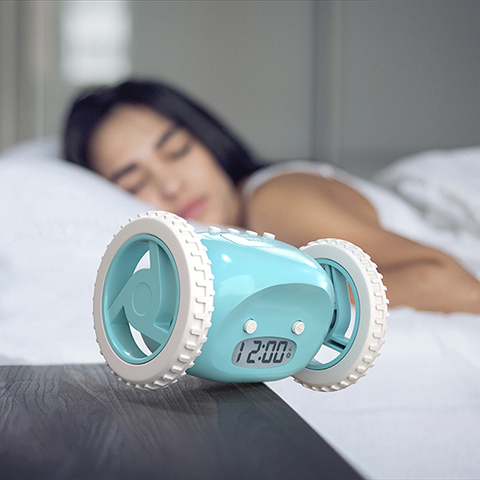
Clocky — is an EXTRA LOUD alarm clock on wheels. What Roomba is for vacuuming the living room, Clocky is for getting you to actually wake up and start your day. When the alarm goes off, you get one chance to snooze, but after that, Clocky rolls and runs away, and you have to chase after it!
An MIT student who had trouble getting herself up and out of bed, Gauri Nanda combined her engineering skills with a desire to improve the aesthetics of alarm clocks to make them delightful instead of solely alarming.
Clocky comes in several colors (black, white, light blue, peach, blue, silver, and gold). It sells for $39.99 on the web site and on between $20 and $40 on Amazon, depending on the style.

Little Hippo’s Mella Sleep Alarm — This kid-oriented charmer is a sleep trainer, alarm clock, sleep sounds machine, night light, nap timer, and digital nanny (helping convince your tiny humans to stay in bed until it’s time to actually wake themselves and the rest of the house).
Mella is white with accent features in Arctic Blue, Blush Pink, Bright Purple, Tropical Teal, and Kickstarter Green. You can buy Mella from the website or on Amazon for $49.99.
Pavlok’s Shock Clock 2 — This wrist-band waker-upper seeks to retrain your brain to make waking up about engaging your mind immediately. Pavlok’s Shock Clock 2 is very high-tech, able to track your sleep patterns using advanced motion detection via a 9-axis accelerometer. (No, don’t ask me what that is.)
To take advantage of your sleep rhythms, you can set the alarm so that it will only wake you between 0 and 20 minutes before your pre-programmed time to ensure it wakes you during the lightest stage of your sleep cycle.
The clock wakes you and gives you assignments to get your brain and body moving; if you’re a heavy, heavy, “I-hate-you-go-away” sleeper, it might make you do jumping jacks; Fitbit-style, it knows if you’re jumping (and no, unlike with Fitbit, you can’t put the Shock Clock 2 wristband on your dog…and I doubt your dog can do jumping jacks). The alarm won’t turn off until you’ve responded to its order to jump with “How high?” (OK, I made up that part.)
The Shock Clock 2 might assign you other kinds of activities, like going on a treasure hunt around your house to scan QR codes placed in various locations. If you seriously want to train yourself out of snoozing, this is definitely an intense way to go about it.
The Shock Clock 2 comes in red, blue, pink, and black, and costs $149 at the Pavlok store.
Ruggie Alarm Clock — This doesn’t even look like an alarm clock; rather, it looks more like a cozy bathroom rug for keeping your tootsies warm when you get out of the shower. But Ruggie is sneaky.
You can’t just hit the snooze. You have to get out of bed, and STAY out of bed for at least three seconds, with both feet on the pressure-sensitive mat. Plus, Ruggie has a library of morning greetings so your can personalize the start of your day with affirmations, empowering messages, and giggles.
Ruggie is a little too popular; it’s out of stock right now, but check back with the company, because this could be a fun way to entice yourself (or your not-so-self-starting kids) to get out of bed.
FURTHER RESOURCES
If you have any heavy sleepers in your house with special wake-up needs, consider perusing:
The Best Alarm Clocks for Sleepyheads (ADDitude Magazine)
When Alarm Clocks Fly: The Tools to Get You Out of Bed — The Best Alarm Clocks for Children and Teens with ADHD (ADDitude Magazine)
19 Best Alarm Clocks of 2022 (NYMagazine’s The Strategist)
Just remember to bear in mind what I said about light disturbing your sleep, and check reviews for mechanical clocks to make sure nobody is complaining about ticking noises.
Do you wake up on your own, or do you need an alarm? Is an alarm (on your phone or alarm clock) not quite enough? What’s your ideal way to wake up in the morning?
Have I convinced you to keep your smart phone out of the bedroom?
Please share in the comments and let us know how you wake up.

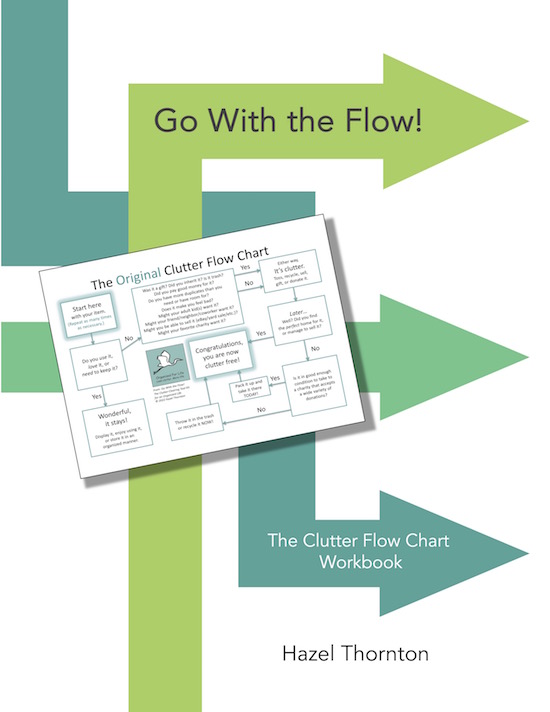
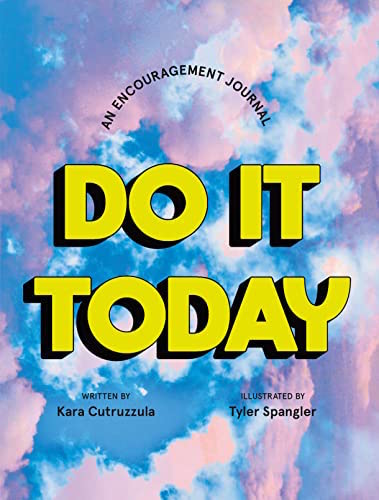

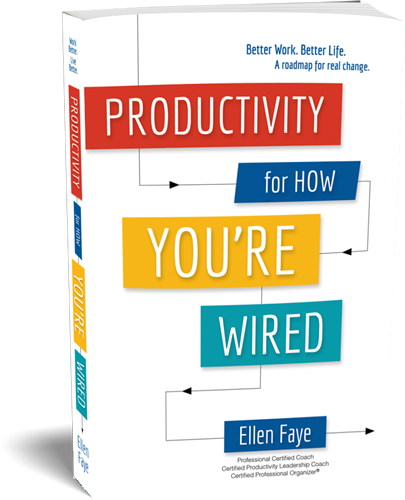
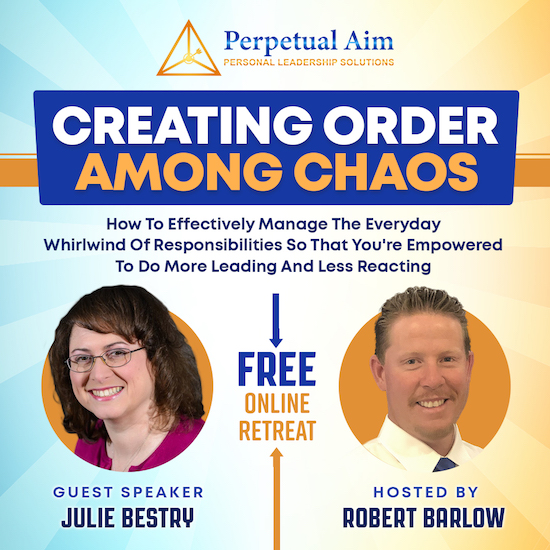


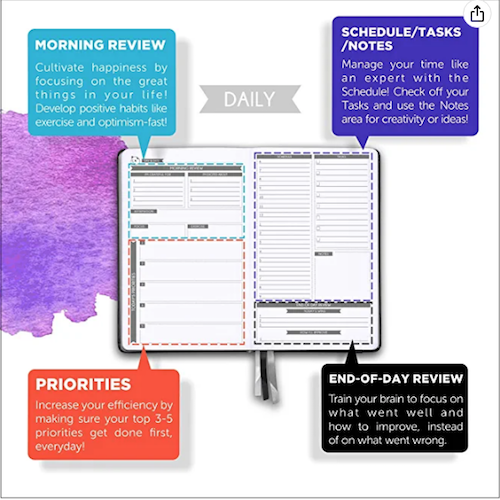

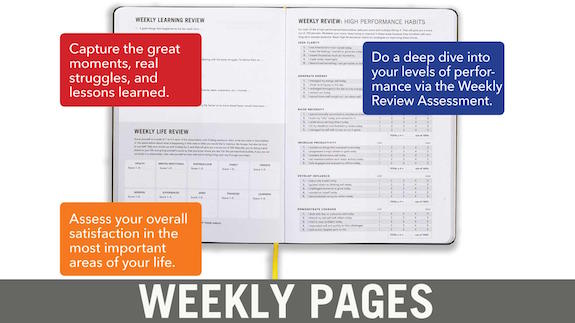



Follow Me